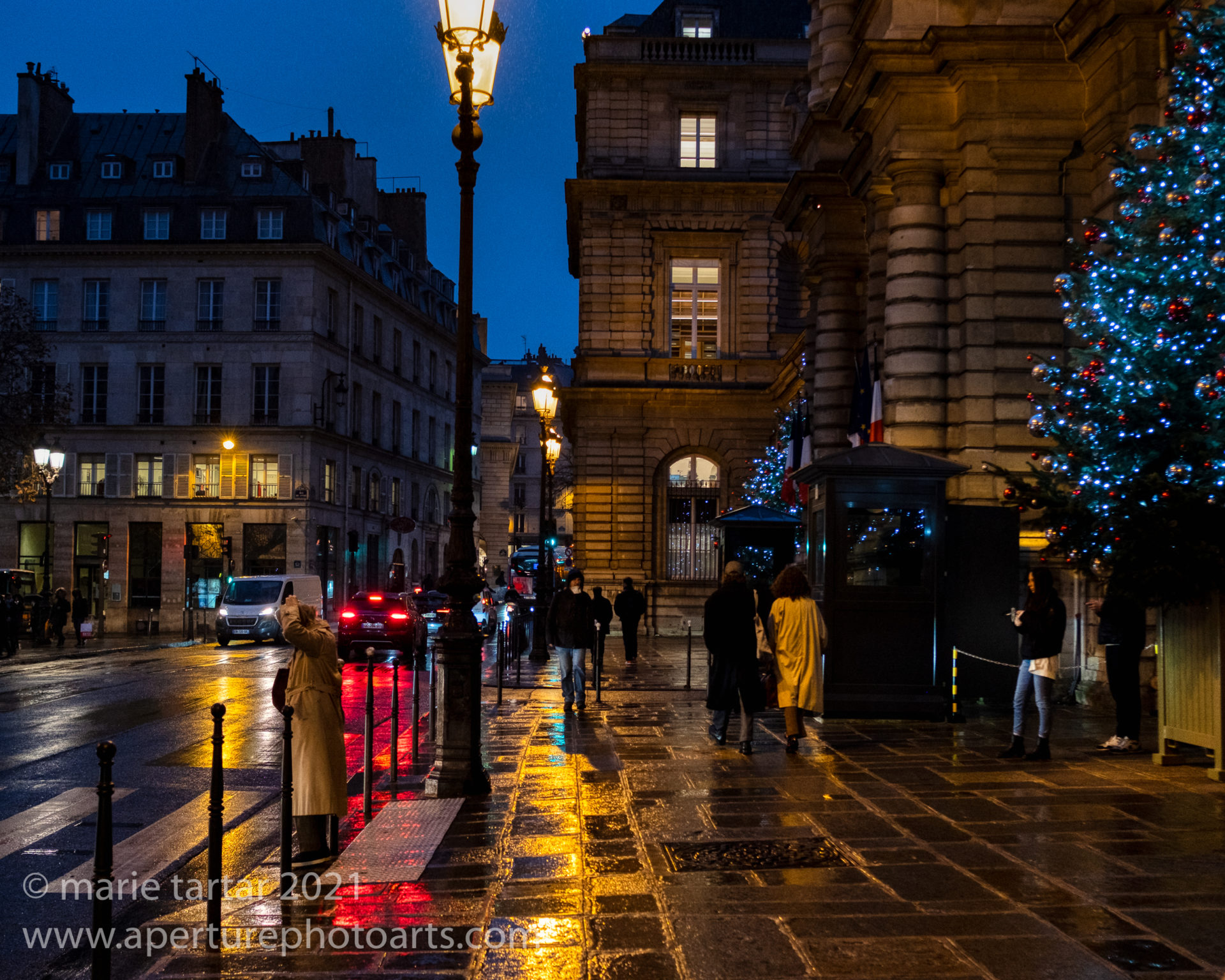
My feet were the only part of me not sad about leaving Paris. Over 9 days, we covered many miles on foot, subway and occasionally, the bus, exploring and re-acquainting ourselves with our beloved City of Lights.
I started to title this post Paris Post-Pandemic, but of course, that wasn’t exactly right. It was our first international trip since the pandemic began and it had been an interminable length of time, 6 years (!), since our last trip here. The pandemic was responsible for 2 of those years, but strangely, it also was the reason we were here now. A lull in the waxing and waning of the pandemic and reports of four different sets of friends who ventured abroad in the summer and fall of 2021 encouraged us to go, once an unforeseen, gigantic eclipse hole opened in our schedule. In late September, just two months before departure, we learned our planned 3 week special Falklands, South Georgia and Antarctica trip, organized around a Southern Ocean total solar eclipse on December 4, was off.
The email announcing the cancellation informed us that “…quarantine restrictions imposed by the Falkland Islands would have forced us to create an awkward itinerary for this cruise that we feel is less than ideal and does not meet our standards for delivering an exceptional experience.” In addition, it was “past the point where we would have to bring the Sea Spirit south from the Canary Islands (where she’s been since March 2020) in order to be ready for the November 20 departure.”
Did we want to move to a later departure? Still working nearly full-time (90%), we didn’t have that flexibility.
We considered a plethora of possibilities to fill the sudden 3+ week opening in our schedule. Iceland in the winter to photograph the ice caves? Diving in Florida, combined with Art Basel? Paris won out, largely for ease of logistical simplicity and because it had been, simply, trop longtemps.
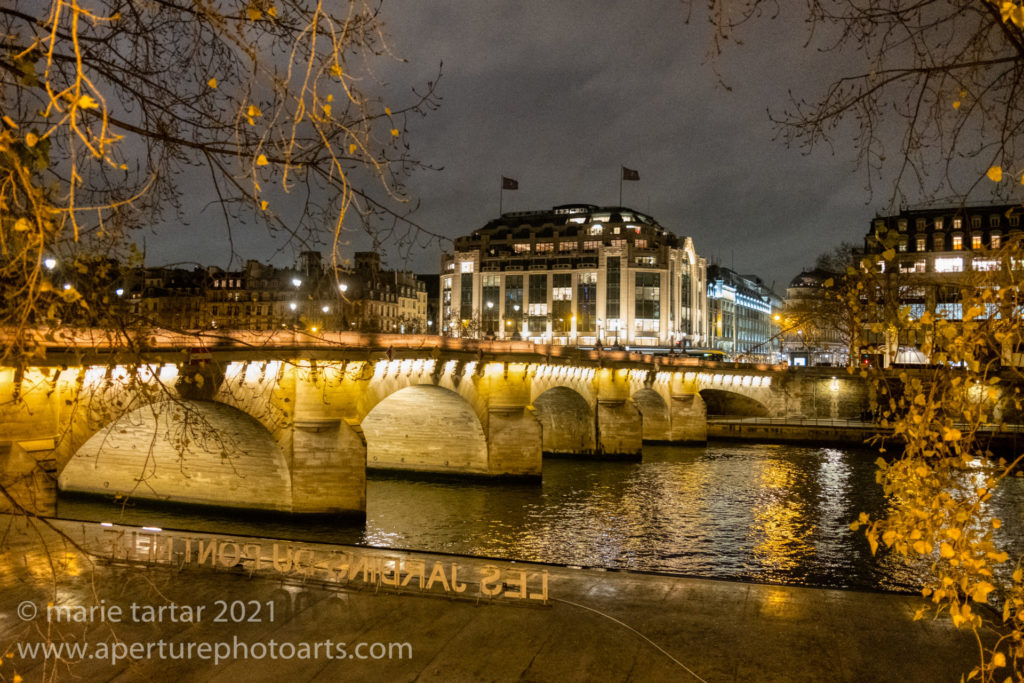
A few yellowing fall leaves remained during our winter trip. The refurbished Samaritaine department store glows on the Right Bank at the Pont Neuf.
For months, reports from friends visiting Paris titillated us. Cindy and Gerry, Vivian and Joe, Mayde and Jon and Margie and Mike all had encouraging reports. Proof of vaccination was required partout, but the logistics for obtaining the required Pass Sanitaire proved to be a moving target.
It turned out to be simpler and much less expensive to do a New York-Paris trip within a New York trip, than to do a multi-city itinerary of Paris, followed by New York and then Sedona.
It was settled, a long weekend Friday-Monday in New York, to Paris for 9 days, back to New York for another long weekend (Thursday-Monday) and then back to California to switch gears, load the mountain bikes onto the car and drive out to Sedona.
Because of the pandemic, desultory popping into museums without advance planning wasn’t encouraged, since most were requiring timed entries, so this trip was going to have to be mostly organized in advance.
My friend Patricia, who retired in Paris and knows the city intimately, was a huge help in organizing this trip.
Traveling to France during a pandemic certainly introduced its own complications. How to get the Passe Sanitaire was a major pre-trip preoccupation. Every link I tried seemed to be a dead end. It turned out that the system for online application, which had mostly not worked for our friends who ventured abroad earlier, had been discontinued. They had applied online, mostly not received the Passe on time and managed by showing their CDC vaccination cards instead. But it was clear that this might not continue to work. The Passe would be necessary to visit museums and dine in restaurants, and advance reservations and timed entries were necessary, even for free museums. There would be no winging it on this trip, so many pre-trip evenings were devoted to requesting restaurant reservations and museum entries.
Monday-Tuesday, November 22-23, 2021
Continuing my efforts to resuscitate my languishing French language skills, I watched two films en route to Paris, La Fine Fleur (The Rosemaker in English) and Le Discours (The Speech in English). Both were good films, but Le Discours made me laugh out loud, with Benjamin Lavernhe as self-conscious, awkward, 35 year old Adrien, whose family drives him nuts, whose girlfriend (Sara Girardeau) has unexpectedly put their relationship on pause and whose future brother-in-law has thrown him into a quandary by asking him to make a speech at his upcoming wedding to his sister.
The pharmacies were closed at CDG when we arrived in the dark of early morning, so there was no obtaining the Passe Sanitaire in the airport as hoped. The sun was just peeking out at 7 am, after we scooted through immigration in a whisk. We bought 2 RER tickets for the trip into town to Luxembourg station.
Fortunately, we were able to check into the apartment early. My attempt at a 2 hour catch up nap in the morning was largely unsuccessful. I hadn’t slept on the plane where, in addition to watching movies, I finished reading My Place at the Table by food writer and restaurant critic Alexander Lobrano, another of Patricia’s excellent suggestions.
I had picked out a pharmacy on rue des Ecoles to target to obtain our passes, but popping into the first pharmacy we passed en route, we successfully converted our CDC cards into French QR codes within 5 minutes, pas de problème. These were on paper, which we later uploaded onto the TousAntiCovid app on our phones, to be produced at museums and restaurants throughout our stay.
Rather than risk falling asleep at dinner our first evening, I scheduled us for a Saint-Germain Paris by Mouth food tasting. I had pursued a similar strategy in the Marais on my last trip to Paris, with the tour helping to unlock vetted sources for provisions in the neighborhood. This was again led by Jennifer, an American living in France for years and now a French citizen. She has an informative blog, Chez Loulou, detailing her cheese obsession and the hows and whys of living in France.
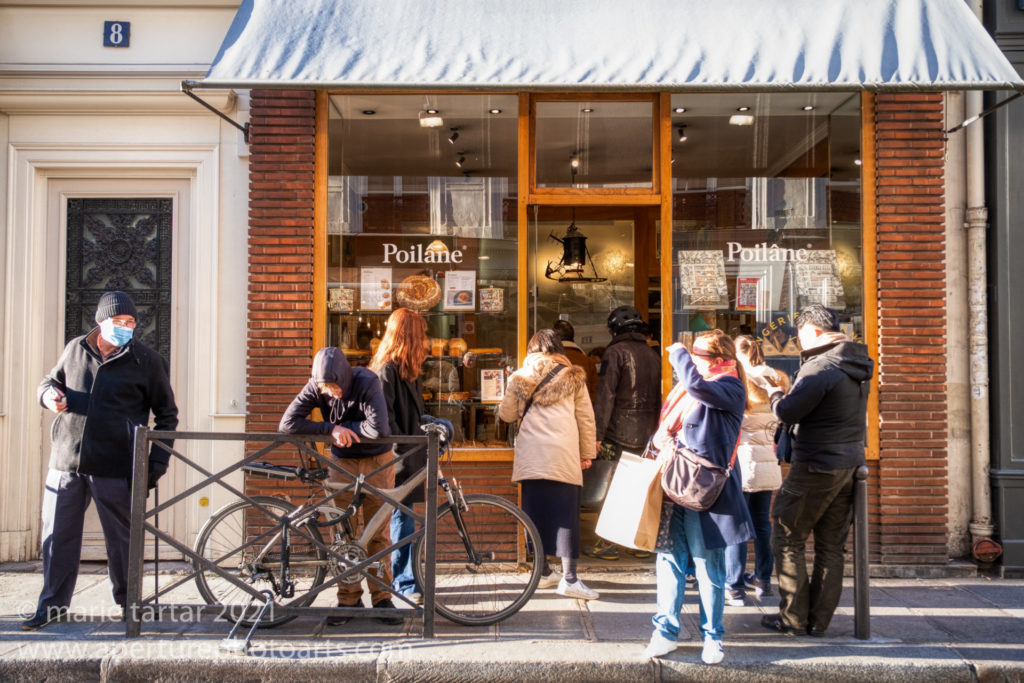
We were very lucky in our travels. The only lines we encountered were to get into Poilâne, a bakery worth waiting for!
Jennifer sent us a wonderful summary email after our tour, outlining the places we visited and what we tasted:
-
Poilâne bakery at 8 rue du Cherche Midi, 75006 (apple tartelettes, punitions (butter cookies) and sourdough miche loaf)
-
Chapon Chocolaterie at 34 rue Saint Sulpice, 75006 (smoked salt and hazelnut praline Dome and dark chocolate ganache dark chocolates)
-
Marché Couvert (covered market) de Saint-Germain at 4/6 rue Lobineau, 75006 (charcuterie from Serge Caillaud – rosette de Lyon, goose rillettes and duck pâté, and cheese from Fromagerie Sanders)
-
Arnaud Larher pastry shop at 93 rue de Seine, 75006 (lemon meringue tartelettes and macarons )
-
La Cave du Sénat at 16 rue Vaugirard, 75006 (wines listed below)
Wines we drank:
2020 Côtes du Rhône AOC blanc “le Abelhas” from M Charpoutier (100% Roussanne from the Rhône Valley)
2020 Régnié AOC from La Bonne Tonne (100% Gamay from Beaujolais)
Cheese we tasted, in order:
Selles-sur-Cher AOC (goat, Loire, 10-21 days): flat disk with a moist, heavy and claylike texture. Aged at least ten days but usually three weeks
Beaufort Chalet d’Alpage AOC (cow, Rhône-Alpes, aged 5-36 months) – made in the French Alps since the 14th century when local landowners instigated a program to remove much of the woodlands and create mountain pastures. These are unplowed and unfenced and contain thousands of different species of wild herbs, meadow flowers and grasses. The resulting milk is sweet, nutty, aromatic and complex. It takes the milk of about 35 cows to make Beaufort, so herdsmen have since ancient times combined their milk, forming cooperatives and shared the tasks of herding, milking, cheesemaking and maturing. Historically the curds were cooked in large cauldrons, which would dry and concentrate them, creating a more complex flavor profile. Cooked milk flavors reminiscent of the steamy froth on a cappuccino. We tasted a 1+ year old version.
Coulommiers (cow, Ile-de-France, 4-7 weeks) – this cheese doesn’t carry the name Brie, but many consider it to be the “mother Brie” who spawned the style. Its flavors are lactic and mild on the spectrum of Brie, but it has the characteristic runny interior and bloomy rind.
Hércule (sheep and goat, Aquitaine, 9-12 months) – an artisan cheese made in the Basque region that combines the milk of both sheep and goats. Smooth and well balanced with sweet, buttery notes and a bright, acidic tang. Traditionally the shepherds would keep a few goats mixed in with their flock of sheep as an early warning system for disease, as the goats would display symptoms before the sheep, and would sometimes mix the goat’s milk in with the sheep milk.
Brin d’Amour (sheep, Corsica, aged 1-3 months) – also known as Fleur du Maquis aux Herbes or Macchione, this soft textured sheep’s milk cheese has a pronounced herbaceous flavor because of the wild herbs and chili peppers (in the case of Brin d’Amour) packed onto its rind.
Jennifer sent us home with the leftovers, as the other walking tourers, a family of 4 from Dallas, were leaving the following morning for Alsace.
Wednesday, November 24, 2021
We had scheduled a viewing with Justine at 3 pm of two 3 bedroom fractional apartments on rue de l’Université and rue de Saint-Pères . The proximity to the Musee d’Orsay and availability of an 11 am timed entry determined the program for our day, where we enjoyed an exhibition called Enfin le Cinéma! and ingested a mediocre lunch at Cafe Campana (lasagna, pasta was too thin and soft, although the sauce was savory).
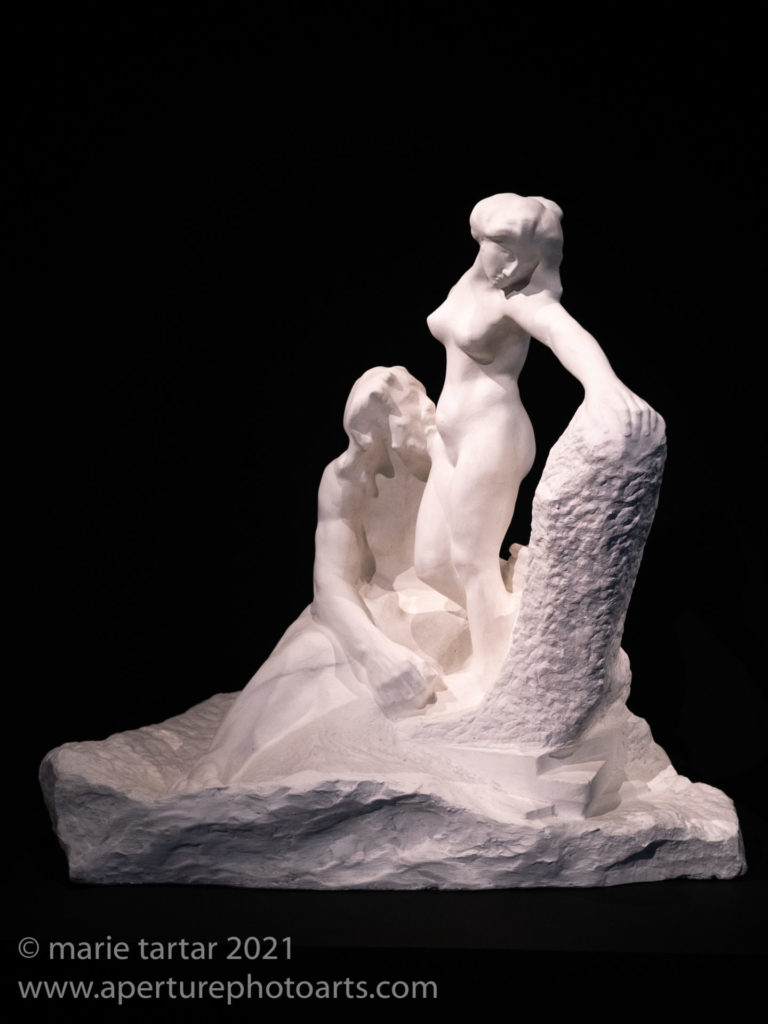
A beautiful marble sculpture of Pygmalion and Galatea by Rodin opens the Musée d’Orsay’s Enfin Le Cinéma! show. The myth of Pygmalion, the sculptor who fell in love with his beautiful creation, Galatea, who came to life from inanimate stone (with the intercession of Venus, the Goddess of Love) is a launching point for this exhibit, drawing analogies to the transition of photography (inanimate) to cinematography (animated).
From the internet, I had expected to love the apartment on rue de Saint-Pères, but neither of us were taken with it. We were both astonished to love everything about the apartment on rue de l’Université. Running into one of the owners in the stairwell on our way out, we had a chance to quiz him and even scored a recommendation for a favorite French restaurant of his in New York (Raouls’ on Prince in Soho). Afterwards, we took advantage of our proximity to la Grande Epicerie to provision for our stay and jumped laden into the Métro, back to the apartment to stretch Steve’s back and rest my feet.
Restored, we jumped back onto the subway again with our new Navigo libre cards (a great improvement over the little paper tickets) at Jussieu, heading towards Théâtre Mogador for an evening transported to Pride Rock and South Africa, with Patricia, her sister Cynthia and The Lion King (le Roi Lion). Even without supratitles and sung in French and Swahili, it was a blast! The French audience, masked and vaccinated, loved it and so did we. Thoughtful Patricia had prepared healthy snack bags for all of us, so we didn’t have to queue at intermission.
Thursday, November 25, 2021
Our first stop today was North Face. Steve had discovered the gloves we brought for him that I thought were his seemed too tight and the Allbirds walking shoes I had ordered to be shipped to New York didn’t come in time, so I only had one pair of ankle boots with me. I found a pair of fuzzy-lined, warm and city smart ankle boots, a relief for my already taxed and aching feet.
On the food tour, I had glimpsed Bernard Zins custom pants, so we stopped in on our way to lunch at Chez l’Ami Jean to see how it worked. Custom orders take 4-6 weeks, but unlike Proper Cloth, if something in the store fits, one can buy it. I found a great pair of gray wool trousers.
It was a long walk down rue de Grenelle to our lunch at Chez l’Ami Jean. The tables are so close to each other, they are literally touching. To my left, a couple from San Diego had just arrived that morning for an annual trip celebrating her birthday. To my right, another couple was from Israel. The tiny place was jammed and rocking . The smells arising from our neighbor’s choices were incredible. It was all I could do not to ask for a taste of my San Diego neighbor’s hare stew. She left most of the huge portion untouched! We were well prepared from the web not to over order. We shared a lobster soup, a stewed lamb shoulder with carrots, served with smooth mashed potatoes and ended with a delectable rice pudding, for which they are justifiably celebrated.
We walked the substantial meal off by making our way on foot to the Luxembourg Gardens. Our destination was the Vivian Maier exhibition at Musée Luxembourg, which was surprisingly crowded. We both had been enthralled by the documentary 2013 film, Finding Vivian Maier, which pieces together the story of the mysterious street photographer who worked for decades as a nanny and never exhibited her prodigous output. This was the first time we’d had a chance to see her work, much of which she never developed during her lifetime and might well have languished undiscovered but for a fortuitous purchase by a young Chicago historian of a lot sold at auction for non-payment of storage fees.
I felt the first touch of daytime fatigue as I listened to the commentary in French. We caught the bus home in a light drizzle.
Patricia invited us over for dinner. She became the owner of a nice new 2 bedroom apartment since I last saw her. The 10 subway was direct. Her sister Cynthia recently retired and is staying with her, trying on Paris for retirement. She had a nice starter spread of smoked trout, dark and seedy Norwegian bread, nuts and apples, with an exceptionally savory and comforting onion soup for dinner, with salad. It was a wonderful, turkey and trouble-free Thanksgiving.
Friday, November 26, 2021
Black Friday has made it to Paris, despite the fact Thanksgiving is not celebrated in France. Amazon is apparently to blame for this outburst of commercialization beyond the twice yearly soldes in January and July.
I found a pair of black patent leather ankle boots, minus 20% thanks to Black Friday, at Clarks en route to our lunch at a small bakery cafe, Mokonuts. We shared a savory starter portion of gnocchi with chanterelle mushrooms. The owner suggested an unusual cider-like Austrian white wine to accompany Steve’s seared tuna with chick peas and bokchoy and my guineau hen (pintard fermier) with charred brussel sprouts and confit (most delicious ever) onion. We split an apple tarte and took to go cookies.
The rain we were expecting was a mere drizzle, so we elected to walk to the Marais. The Les Halles area has been transformed magnificently since our last trip here, with the giant Westfield shopping center (Forum Les Halles) topped with a soaring metallic wing-like roof, La Canopée, inaugurated in 2016.
The design by competition winners Patrick Berger and Jacques Anziutti helps to mitigate the issues stemming from the hole left in the center of Paris by the demolition in 1971 of Paris’ beloved central food market, which Emile Zola immortalized in 1873 in Le Ventre de Paris. In addition to the giant mall which is now covered and somewhat disguised by La Canopée, this is a major transportation nexus, the Chatelet les Halles train and subway station. A new park now spans the area between Les Halles and the transformed Bourse de Commerce, our destination for the afternoon.
The Bourse de Commerce houses a selection of the vast contemporary art collection of François Pinault in a thoughtful and effective intervention by a favorite architect of ours, Tadao Ando. We’ve admired his work in Japan and on a prior trip to Paris at UNESCO. (See more of Ando’s work from our prior trips at these links: in Tokyo, Naoshima (here and here) and Paris.)
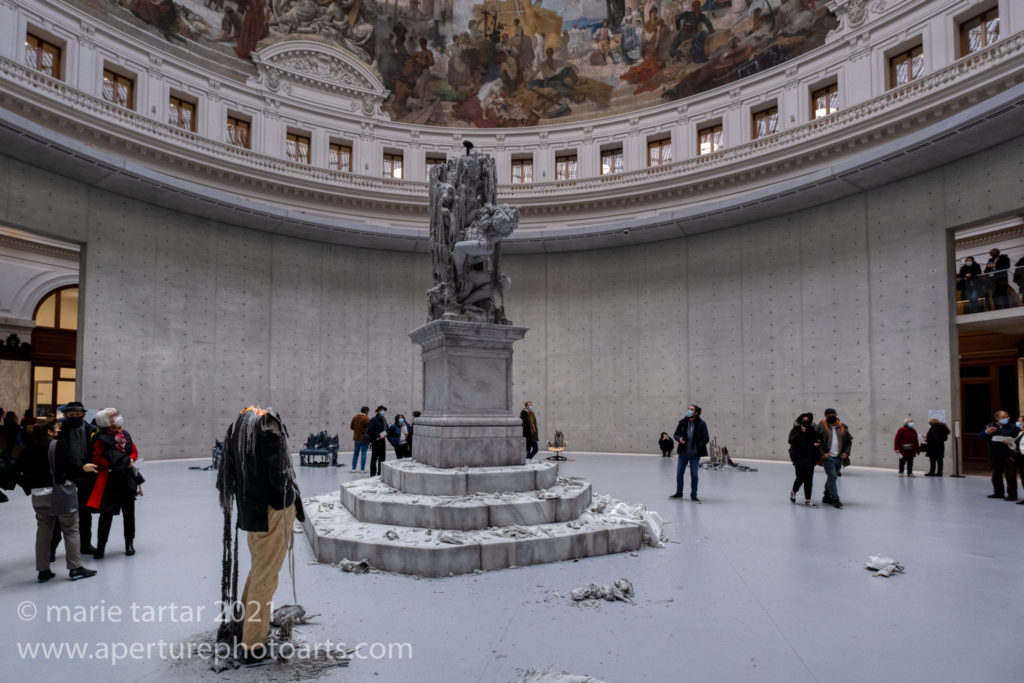
For the inaugural show at the Bourse de Commerce, Urs Fischer created this multi-part piece of molded wax. Installed months ago and the wicks lit, the work has been evolving over time. The figure in the foreground is “Rudi”, modeled after an artist friend of Fisher’s , Rudolf Stingel (whose work is featured in another gallery). Rudi gazes (or at least he did until his head fell off) toward a recreation of the Florentine sculpture by Giambologna, The Abduction of the Sabine Women, on the marble pedestal.
The round structure once was a grain market and is capped by a metal dome dating back to 1812. Ando’s insertion of a concrete cylinder within the structure creates a large round central gallery, with a surrounding concourse.
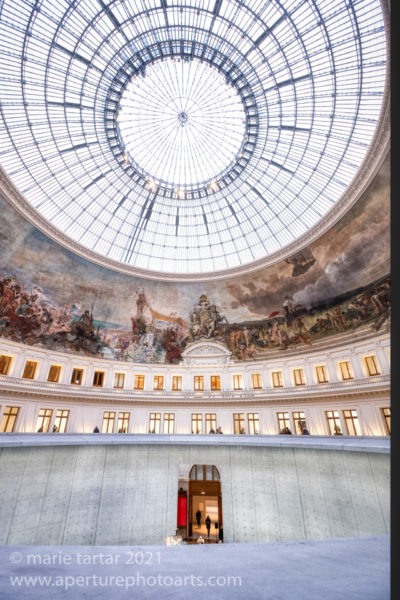
The metal and glass crowning glory of the Bourse de Commerce, a former commodities exchange, was added in 1812.
This rotunda contains 24 glass vitrines, which for this inaugural Ouverture exhibition, houses works by Bertrand Lavier, showcasing objects ranging from a resin, stylized à la Disney, bright green cactus to a damaged hanging red Peugeot moped. My favorite work was evolving in the central gallery, by Urs Fischer, in which he recreated in pigmented wax a Florentine sculpture by Giambologna, The Abduction of the Sabine Women. Another component of this work is Fischer’s recreation of an artist friend, Rudolf Stingel.
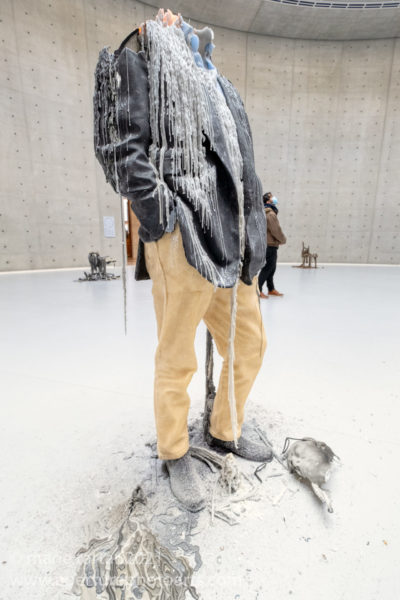
Rudi, the pigmented wax candle version of artist Rudolf Stingel, has lost his head and broken his glasses, seen adjacent to his left foot.
The wax version of “Rudi” gazes at the sculpture, while the artist himself is represented in another gallery by work on the second floor. Both “Rudi” and the Giambologna have wicks imbedded and are effectively large candles. Installed months before and their wicks lit, both have slowly melted and disintegrated into scattered fragments on the floor in a process of “creative destruction”. We previously had admired a similar work of Fischer’s at the new Whitney, depicting another artist friend of his, Julian Schnabel.
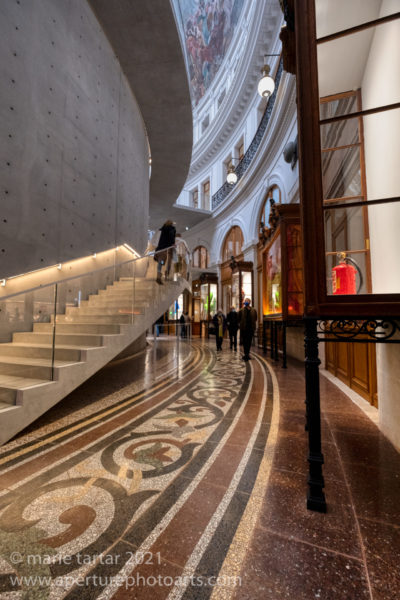
Ando’s insertion into the Bourse of a concrete cylinder (left, with stairs) creates a circular gallery. The artfully lit fire extinguisher? Part of a multi-part piece by Bertrand Lavier, installed in glass vitrines dating back to 1889.
Of the remaining work, I enjoyed seeing several galleries of David Hammons’ work. I vividly recall the first time we encountered his work, in London at the White Cube gallery. Hearing that the large abstract paintings, partially veiled by scavenged tarps, went for sums on the order of a million dollars, made it clear that this well regarded African-American artist’s work was miles out of our financial league.
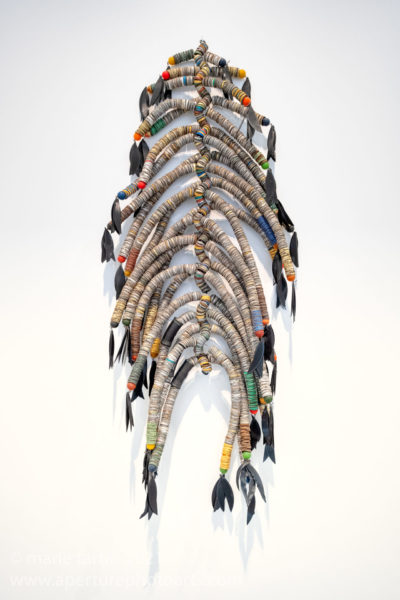
David Hammons, African-American artist born in 1943, has not been widely exhibited in museums, but is well represented in Pinault collection.
Neither of us especially cared for most of the other paintings on display, although I did really like a series of chair sculptures called The Guardians by Paris-based artist Tatiana Trouvé.
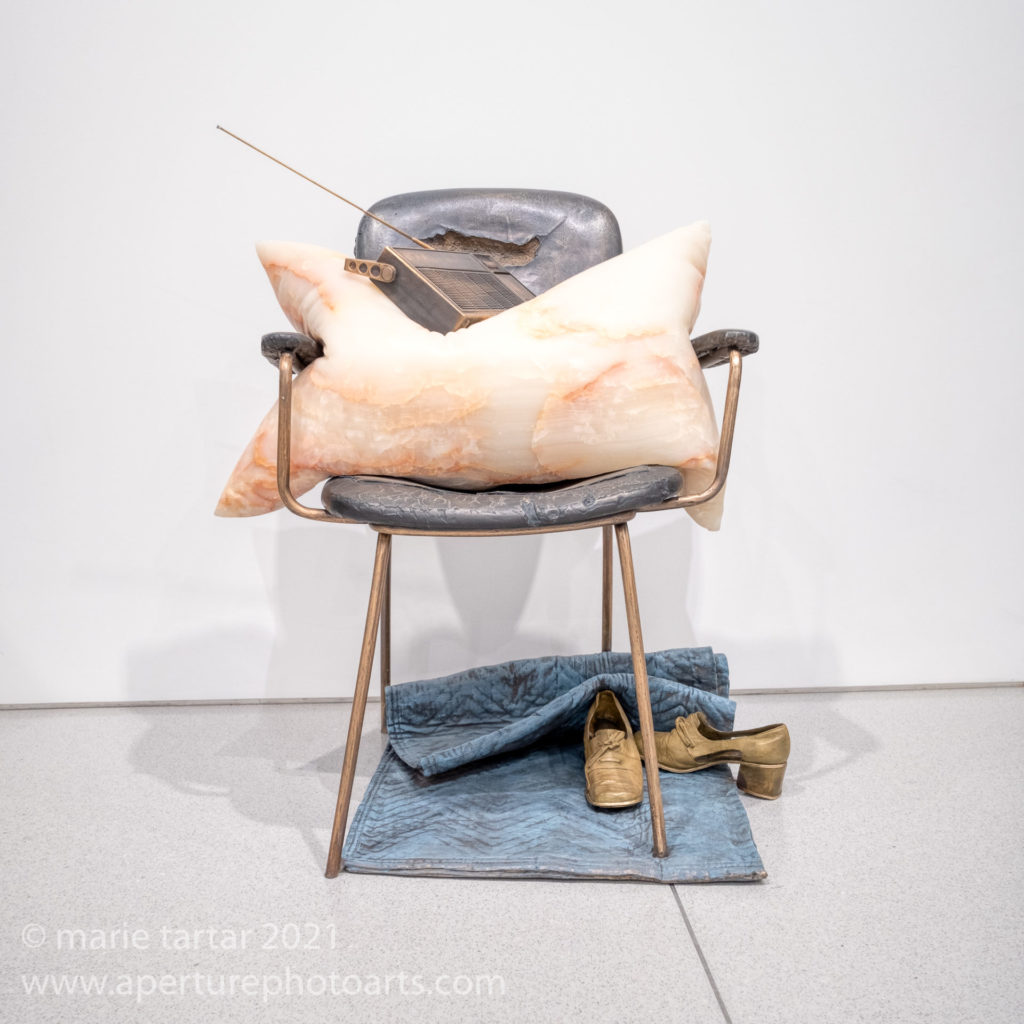
One of a series of Paris-based artist Tatiana Trouvé’s Guardians series which dotted the galleries at the Bourse de Commerce in Paris.
They evoked possible or absent personages, with objects (books, shoes) recalling human presence arranged on the chairs, which were strewn through the galleries as if the museum guards had just left their posts. As well as changing exhibitions, there are site-specific installations, such as an assemblage of 52 stuffed pigeons adorning the interior architecture called Others (2011) by Maurizio Cattelan.
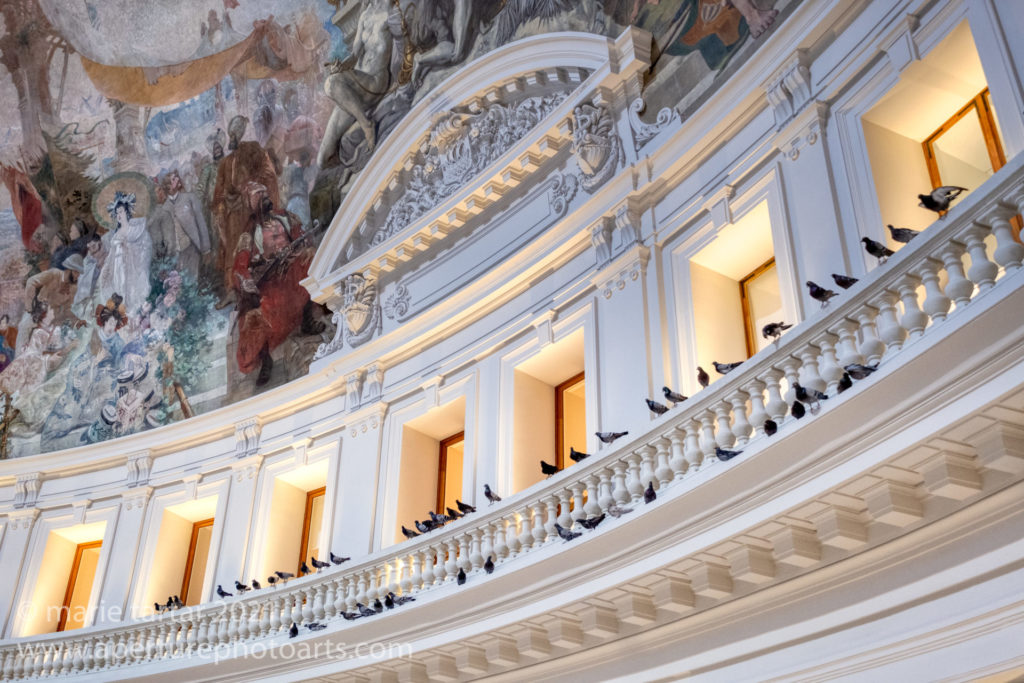
No, the Bourse de Commerce is not open air; these pigeons are an installation called Others (2011) by Maurizio Cattelan.
We headed to dinner on the Left Bank with time to take in the refurbished, historic Samaritaine department store, which was ablaze with holiday lights.

Drop dead gorgeous, restored grand magasin, the Samaritaine department store, ablaze with lights for the holidays, with spectacular Art Nouveau mosaics beneath the glass roof verrière..
At KGB (kitchen galerie bis), we opted for the 4 course dinner with wine pairings, beginning with a trio of starters (dumpling in Thai coconut soup broth, mackerel sashimi and a beet salad). Both main courses, trout and quail, were exceptional. The dessert was a duo of uni ice cream with an unctuously rich chocolate and chestnut ice cream and chocolate crunch.
Saturday, November 27, 2021
We passed a succulent display of roasting chickens with their irresistible aroma as we headed down the hill from the apartment after an unsuccessful attempt at visiting the nearby Pantheon, which Steve had never seen. It was closed, with bleachers being erected in front of it, in anticipation of Josephine Baker’s impending internment there. We would pay her homage the following day at a musical revue based on her life. We did pop into the adjacent cathedral, where a mass was happening, honoring alumni of the nearby Polytechnique school.
After confirming with the butcher that they would be open late enough (8 pm) for us to procure dinner, we meandered through the Left Bank, checking out rue Guenegaud (Margaret’s street), with the goal being to arrive a few minutes early for our 12:30 lunch reservation at Semilla. Studying the menu outside, waiting for the door to be opened, I chatted with two Texans who were returning after having dined there already this trip. This “tapas” style small plates restaurant on rue de Seine had been recommended by Margaret, among others, and did not disappoint. We shared 3 entreés and a main (coquilles St-Jacques ceviche, beet salad, pasta with chanterelle mushrooms and cauliflower roasted with grapes and nuts, with a fantastic quince (coing) tarte tatin to finish.
We were probably the first to order and made it out before 2 pm. We had an 86 bus and metro combo ahead of us to make it to Porte Doree by 2:30 pm to meet up with Patricia to see the Picasso L’Etranger show at the Art Deco Musée National de l’Histoire de l’Immigration. The show examines how Picasso’s foreigner status and association with Russians, communists and Leftists made him suspect in the eyes of France’s police, leading to him being declined for citizenship when he applied during WW II in 1940, after having lived in France for decades.
It was so gray and wet and frigid when we finished at the museum that we didn’t walk home via the Promenade Plantée as planned but hopped on the subway back to rue du Faubourg Saint-Antoine to catch the 86 bus back to the apartment. It didn’t come and didn’t come, until we finally saw a small notice of a “manifestation” interrupting service at the stop. Patricia power-walked us to another metro station, which took us back towards the apartment. We procured a roast chicken with tiny potatoes and wine from the neighborhood boucherie for dinner together at home.
Sunday, November 28, 2021
Persistent cold, grey and rainy conditions did not dampen our ardor for a walk to the Marais. We made a reservation that morning for an 11:30 am lunch at Breizh Cafe. Our two buckwheat galettes, one with leeks and coquille Saint Jacques (Binicaise) and the other with potatoes, cheese, salad and bacon (Savoyarde), were so satisfying (along with a brut Paysan cidre) that we were sadly unable to indulge in a dessert crepe. Although we’d been planning to hit the Musée Carnavalet, we were so close to the Musée de la Chasse et de la Nature that we decided to see if we could go (the Carnavalet was requiring advanced booking even though it is free and we weren’t certain of the Musée de la Chasse’s policy). Pas de probleme, our TousAntiCovid QR codes were scanned, tickets paid for and we were in. It is a delightful and quirky small gem of a museum, with an intoxicating mix of tapestry, contemporary and traditional furniture and artwork in a sumptuous setting.
The cardboard work of Eva Jospin, evocative of the forest, was featured on this visit.
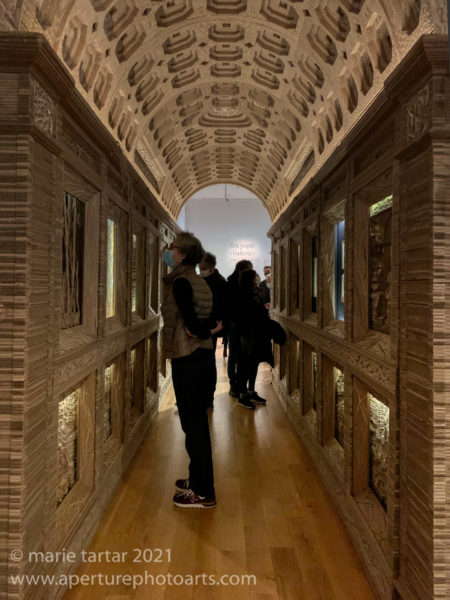
Amazing “architecture” by Éva Jospin, created largely from cardboard, at Musée de la Chausse et de la Nature.
The name of this museum put us off for years-Museum of Hunting and Nature?! Yes, we love nature, but hunting? It actually is a wonderful mix of traditional and contemporary depictions of animals and man’s relation to nature. Years back, we went, only because our French artist friend Milène Guermont had several works on display there. We loved the juxtaposition of everything from feather art to taxidermy.
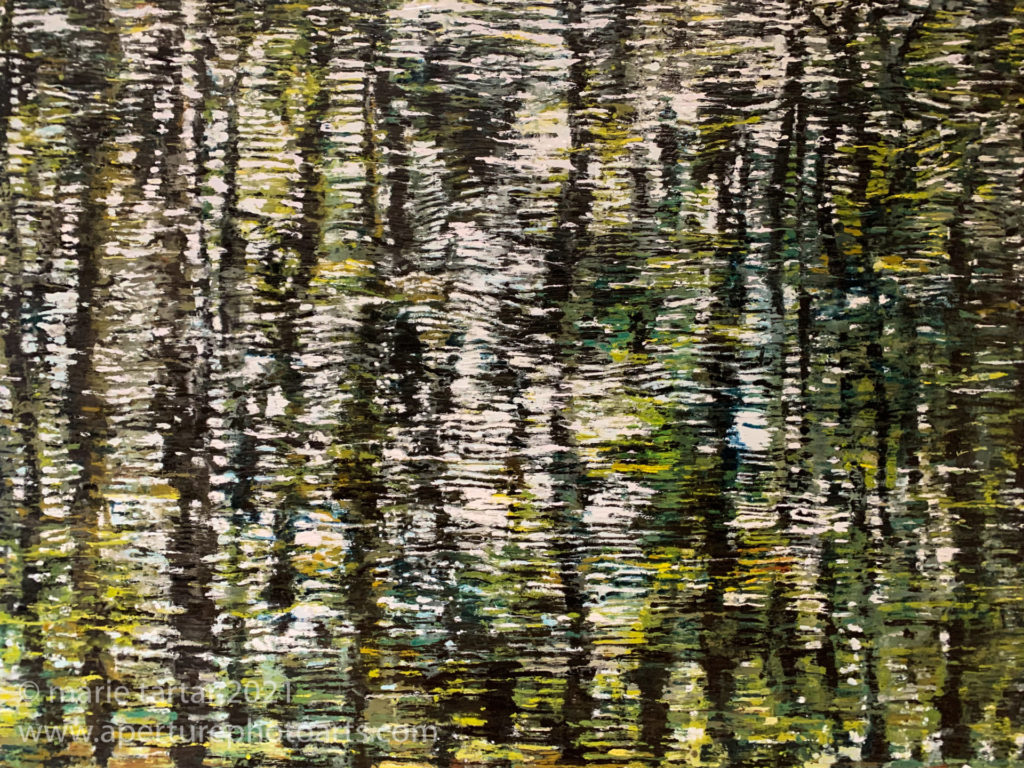
A painting I loved at the Musée de la Chausse et de la Nature, although I failed to note the artist’s name and couldn’t find it on the museum’s website. No wonder I love it, it reminds me of one of my photographs from Japan, which I called Tapestree, taken from the window of a bus in motion (below).

Tapestree, on the way to Miho Museum, forest outside of Kyoto.
As we headed to the subway at Republic, we restocked on bread at Tout Autour de Pain at 134 rue de Turenne, which I remembered from a prior Paris by Mouth tasting tour. A manifestation of some kind was being staged near the Métro stop and a creepy maskless guy was muttering to himself on the last leg of the 10 stop subway ride, making us glad we had to disembark. He was one of only two unmasked faces I saw in 9 days of using the Métro. The masking compliance in Paris on the Métro was extraordinary.

One doesn’t need to understand much French to interpret this message, seen in the Métro and partout: For the health of everyone, let’s wear masks.
Joséphine B was being staged at the small Théâtre de Passy. The timing of this show coincided with preparations being made for her long awaited internment in the Pantheon two days later. She is one of only 6 women ever to be awarded this honor, shared with the likes of Marie Curie. She also is the first American and African-American woman and entertainer to be interned there. Her life, from humble and impoverished origins in St. Louis, to a popular and flamboyant entertainer in Paris to resistance supporter of France during WW II (chatting up German and Japanese diplomats at soirées and recording information in invisible ink on her sheet music), was an extraordinary, storied life.
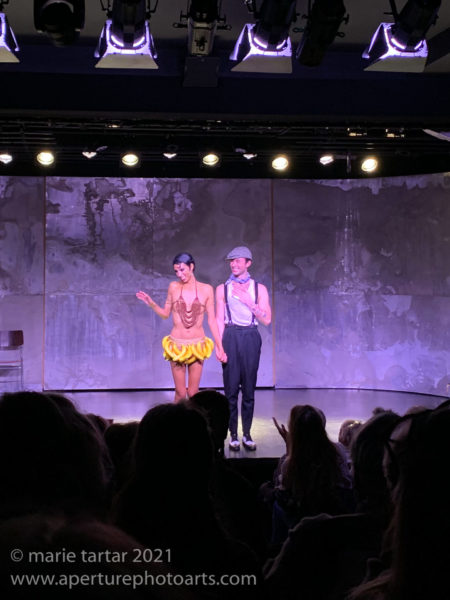
Minimal set and costumes, but a fascinating life story and the banana dance in a musical tribute to Joséphine B(aker).
We capped the evening off with a sumptuous, largely vegetarian dinner at Halle aux Grains on top of the Bourse de Commerce. Patricia and I shared two entrées, one noix saint Jacques and the other oysters, then shared a savory and satisfying souffle-like vegetable main. Steve enjoyed another pink volaille fowl. The tarte tatin was served with a sorbet and cookie crust. An excellent Chenin Blanc (Chidaine) rounded out the meal.

Our first course at the Halle aux Grains, a prelude to a delicious meal at the top of the Bourse de Commerce.
Monday, November 29, 2021
We had to set an alarm clock today, as we were meeting Patricia and Cynthia out west near the Bois de Bologne for a 10 am entry at Fondation Louis Vuitton (FLV), a long ride on Metro Line 1, disembarking at Les Sablons. We left at 8:30 am to walk across the Isle St Louis to Hotel de Ville. There was blue in the sky and sun warmed the scene for a change, although it was definitely Antarctica cold.
Our first, last and only prior visit to FLV was in November 2014 , also with Patricia, when this dramatic, swooping silver colossus was a new addition to the Paris art scene.
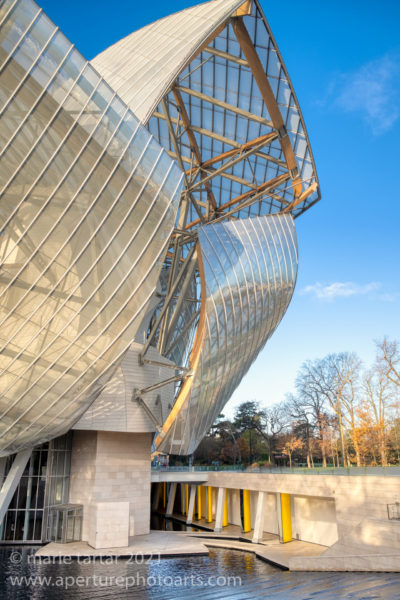
An amazing sight, from any angle, Frank Gehry’s Fondation Louis Vuitton, with Olafur Elliasson’s walkway below right.
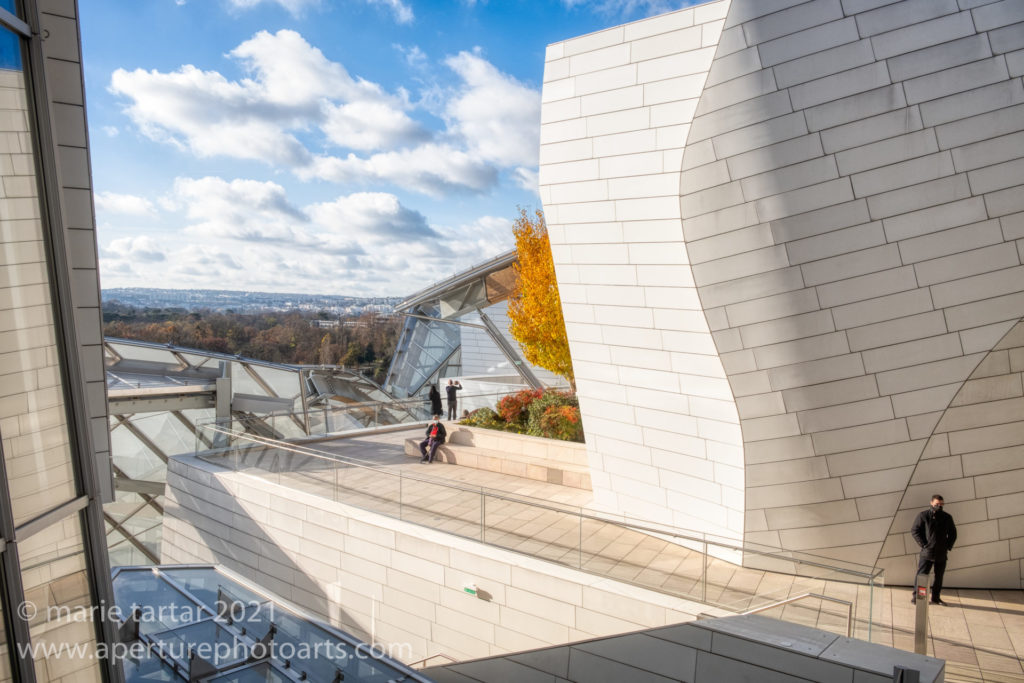
One of the pleasures of Fondation Louis Vuitton are the many terraces from which to admire the views of Paris and the Bois de Boulogne.
The FLV is an easy walk from the subway station and the shiny structure was glowing in the low morning sun.
The feature attraction was the collection of the Morozov brothers, Icons of Modern Art . The brothers were Russian collectors who built up enviable impressionist and post-Impressionists holdings. One brother, Mikhail, died young, at age 33 in 1903, having already amassed a collection of 39 French works and 44 Russian pieces. These were donated in 1910 by his widow to the Tretyakov Gallery in accordance with his wishes. His brother Ivan continued collecting, including commissioning large works by Maurice Denis for his mansion in Moscow, until his collection was nationalized in 1918 after the Russian revolution.

This treasure from the Morozov collection is for Greg, who loves the Norwegian master, Edvard Munch.

This was an interesting, surprising and disturbing work from the Morozov collection, a most unusual Van Gogh, of a prison yard.
Despite it being a Monday morning, les parisiens were turned out in force for this show requiring a timed entry.
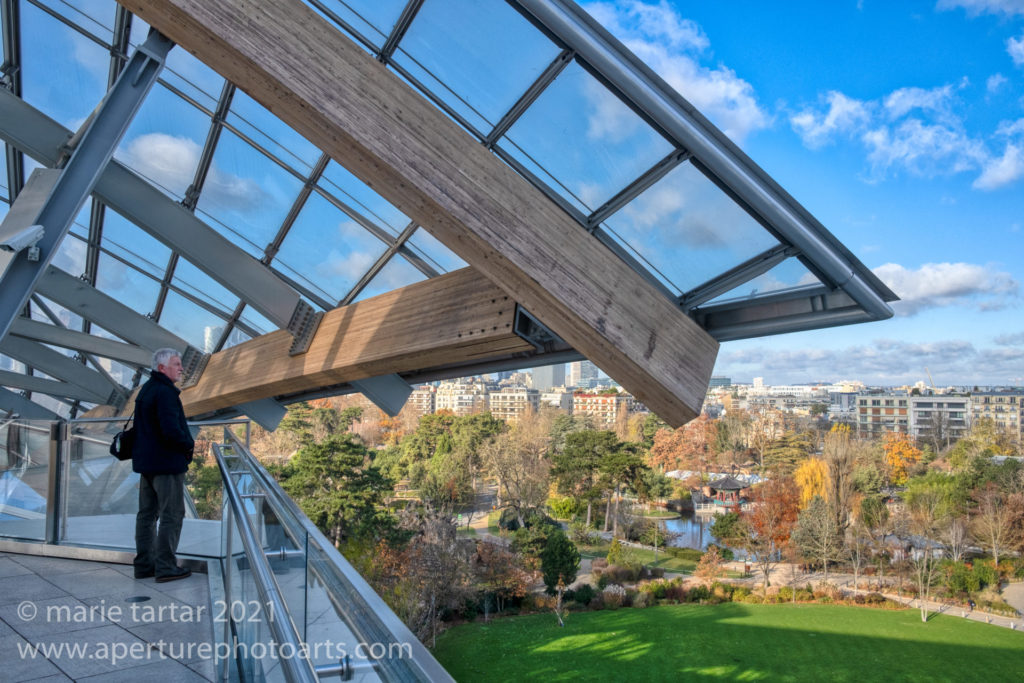
Ever a reluctant model, Steve looks out from one of Fondation Louis Vuitton’s many terraces at the Bois de Boulogne and le Jardin d’Acclimatation.

Fondation Louis Vuitton has an interesting, self-referential, fun-house aspect to it, especially this corridor with yellow lighted panels by Olafur Eliasson.
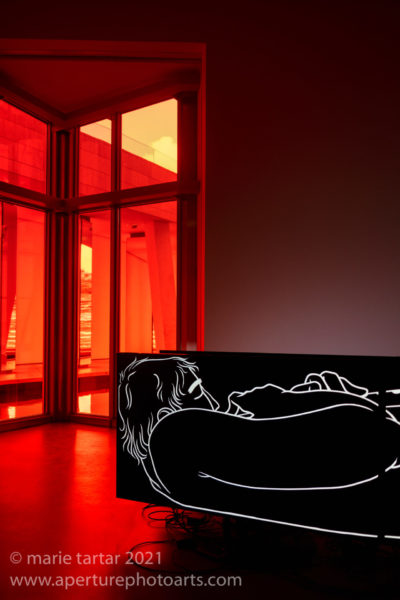
Interesting pandemic-inspired artwork by Özgür Kar, an artist of Turkish extraction living and working in Amsterdam, called MACABRE, features two reclining video figures in a langorous dialogue about life and death. On this side, a boy Snake Charmer with a clarinet; on the other, a skeleton representing Death, derived from Middle Age depictions.
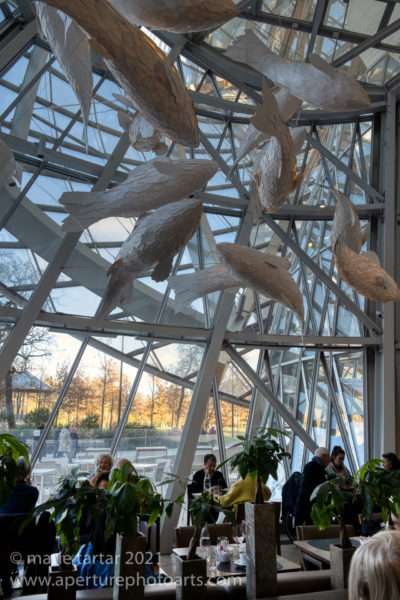
I enjoyed the fishes overhead at Frank, the restaurant at Fondation Louis Vuitton, more than the lunch itself.
For dinner, we ventured back to rue Christine, where we had once stayed, dining at Chez Fernand, where we shared a boeuf bourgonon and tarte tatin, with chanterelles,. To start, I tried the razor clams and Steve had onion soup.
Tuesday, November 30, 2021
We breakfasted at home on sandwiches made from the left-over roast chicken.
The Musée Carnavalet has been freshened up since our last visit. Closed for 4 years for this project, it reopened earlier this year. It is a treasure trove of artifacts, period rooms, paintings and memorabilia of Paris and its residents through the ages.

Everyone’s favorite room au musée Carnavalet, Galerie des Enseignes (Hall of Signs), has a new stairway as part of restoration, a collaboration of the architectural firms Snøhetta, l’Agence NC (Nathalie Crinière) and Chatillon.

Many French museums occupy former residences of the nobility, including Musée Carnavalet, the museum of the City of Paris, which spans two adjacent hôtel particulier (private mansions), including the former home of Madame de Sévigné.
Afterwards, I found a sweater I liked (20% off!) at nearby Norie M, near the Place de Voges. Gerard Mulot is no longer there. I will have to find a new source for cherry clafouti.
We met up with Milène in the Nouvelle Athène section of Paris, to see her work in progress, a comprehensive art project apartment, where she is designing everything, from the light fixtures to the sculptural door pulls and the triangular faucets, evoking her Phare work.
From there, we walked south to rue de Nil for dinner at Frenchie, taking advantage of our early arrival to shop for wine at Frenchie’s wine store on the same street. This meal was the culinary highlight of a stay punctuated by many good meals.

A most delicious street, possibly THE most delicious street in Paris?! Rue de Nil, should be renamed rue de Frenchie, as chef Gregory Marchand has gradually expanded his enterprises up and down this short street in the former garment district, Le Sentier. In addition to Frenchie, there is now Frenchie bar à vin, FTG (Frenchie To Go) and Frenchie Caviste wine shop.
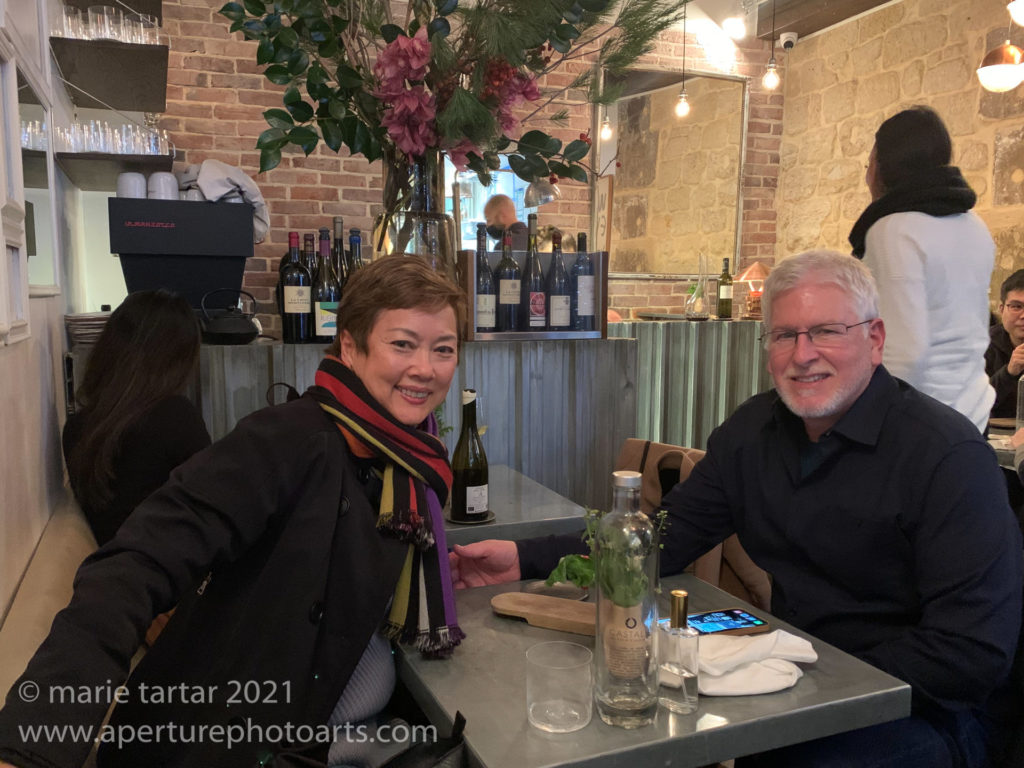
Portrait after a most satisfying meal at Frenchie, by our neighbor from Atlanta, a professional photographer partial to Leicas.
Once home, we had a task to complete. A negative Covid test within 3 days was required to make it back into the US and we now had 2 days to do. I had thought it would be easier to bring tests with us, but a conversation with an adjacent couple from Atlanta at Frenchie’s that night suggested popping into a French pharmacy would have been easier. Our Covid testing would be monitored by video. This turned out to be a multi-step process, requiring setting up on line accounts and a baseline level of Internet facility. Seated opposite each other at the dining room table, we readied our kits and laptops. I went first. The monitor on my laptop had me tilting the screen this way and that, first to see me and then the test materials on the tabletop. While I was engaged with this, I heard a rustling across the table and saw, to my horror, that Steve had jumped the gun on tearing open the wrapping from the testing kit, before getting the monitor on line. How to salvage the situation? A little clean up and straightening with scissors of the ragged edge of the package and creation of a new “Tear here” slit might pass the inspector’s low resolution video scrutiny. The contents were still untouched. Just as I actually had searched for the tear slit, Steve pretended to, turning the package around to “find” it. Thankfully, we both were negative and made it home without difficulty, although the Omicron situation was dynamic enough that by the time we flew home 2 days later, the rule had been changed to require a negative test 1 day in advance.
Wednesday, December 1, 2021
I overslept, with Steve finally waking me at 10:15 am. I hadn’t been able to sleep the night before until the wee hours. We managed to make it to Musee l’Orangerie by 11:25 am, finding a line standing in a sideways rain. Since we were after our 11 am entry time, I found an official, who spotted the membership card in my hand and waved us to the front of the disgruntled line.
I was happy we had made the effort. An oval gallery with Hockney pieces created on an Ipad was a nice counterpoint to the much loved Nypheas of the late, visually impaired Monet.
David Hockney’s charming ribbon of a continuous painting echoed the run-on pandemic year in Normandy.

Hockney combined more than 100 images, initially sketched on an Ipad, during a year of pandemic confinement in Normandy, to form this delightful ribbon record of the 4 seasons.

It’s hard not to be cheered by Hockney’s pandemic project (Detail from Hockney’s A Year in Normandie).
The expressionist swirls of Chaïm Soutine were juxtaposed against the later abstract expressionist work of de Kooning.
Our final lunch was a splurge, a tea pairing, multi-course tasting extravaganza at Yam T’cha, a restaurant I had always wanted to try but had never succeeded in obtaining a reservation. It being winter and tourist traffic reduced by the pandemic probably helped score this reservation. The interior was soothing, with, appropriately enough, a water lily scene on the walls.
We were seated next to a window looking out to an interior garden. The wine room had Nakashima-esque free edges to the wooden shelves.
I think there were 6 official courses, but in reality, there were many more tastes, with 3 amuses bouches to start and two separate desserts.The teas were served in tiny pots, with a very necessary lacquer draining tray underneath. The teas were nice, but neither of us were entirely sure we could discern the subtle nuances of the pairings. The food was excellent, served on a beautiful array of dishes. From preliminary tastes of oysters in a rice porridge and matchstick julienned vegetables with smoked tofu wrapped in a tofu skin to the the dessert finales of sorel soup with ice cream and mango, papaya and dragon fruit with fromage blanc, it was a most enjoyable feast. In between, we enjoyed course after course: tuna with leeks, a seafood soup, fried squid, chicken wok stir-fried with black beans and onions and bao filled with melty blue cheese and tangy cherry.
Our afternoon digestive was viewing a collection of photographs from MOMA at the Jeu de Paume.
The mid-day feast did not spoil our appetites for a final dinner of salmon with leeks with Patricia and Cynthia. Patricia had scored an early galette des rois, an almond paste-filled pastry confection sold in patisseries in France around the holidays to mark Epiphany, celebrated on January 6 (12 days after Christmas) as the day Three Kings visited the baby Jesus in the manger. The cakes are sold with a gold-foil crown, which is used to crown as le roi /la reine the person receiving the slice in which a fève is baked. Fève (bean) most often is a tiny porcelain figurine. Being a licensed physician and surgeon, I was tapped to slice up the galette and had already served the others when my knife struck something hard-la fève-in my slice! (Better than finding it with a tooth, for sure.) Here is my adorable, tiny ceramic souvenir of a wonderful holiday season stay in Paris:

Queen for an evening: by finding this tiny ceramic fève hidden in a galette des rois with my knife, I was crowned La Reine for a most enjoyable evening on our final night in Paris with Patricia, Cynthia and Steve.
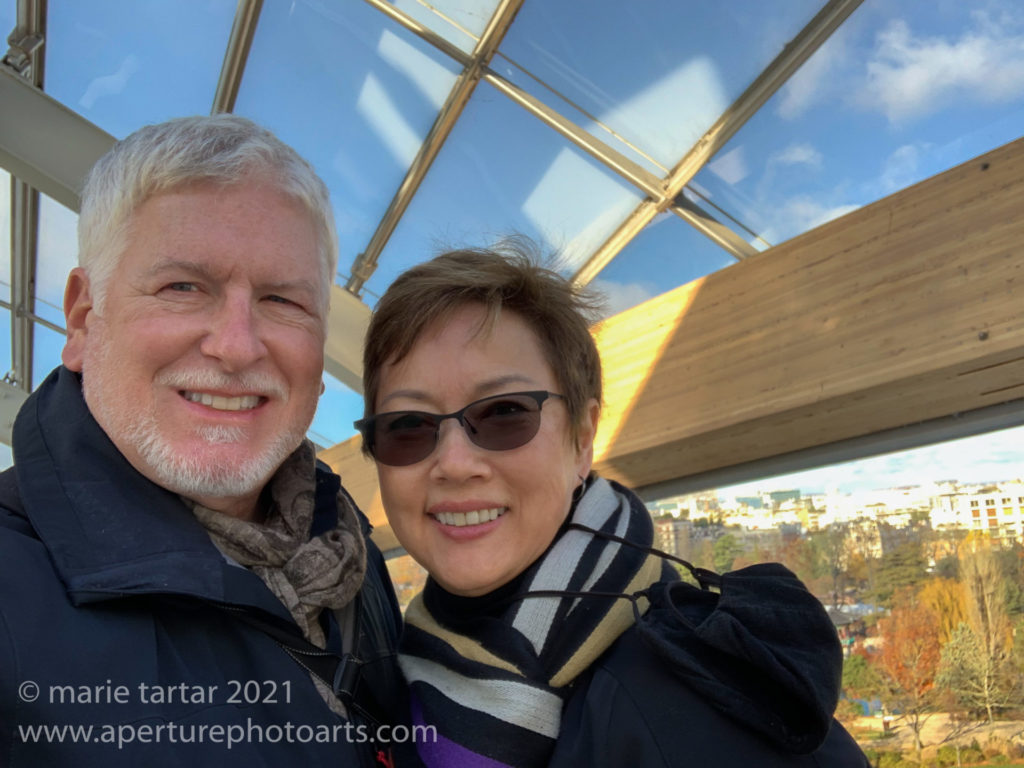
A rare groupie, especially with all eyes open at the same time! Evidently, Paris agrees with us. Au revoir from Fondation Louis Vuitton!



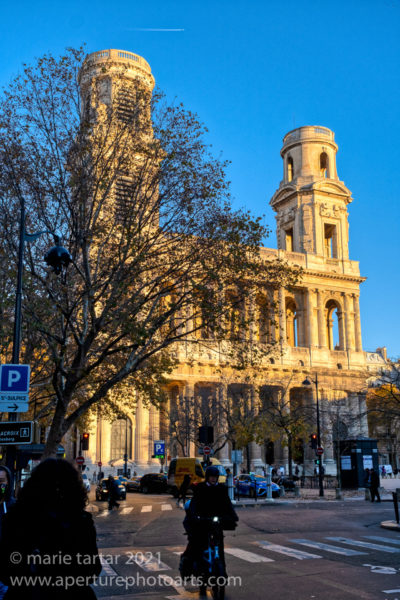



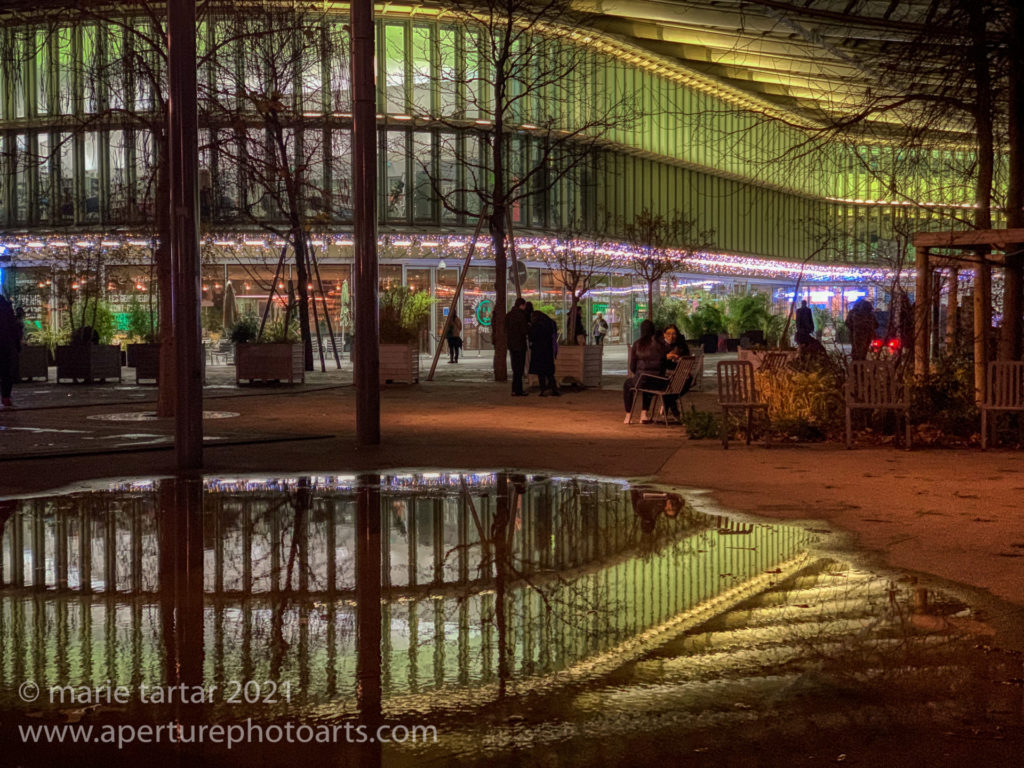
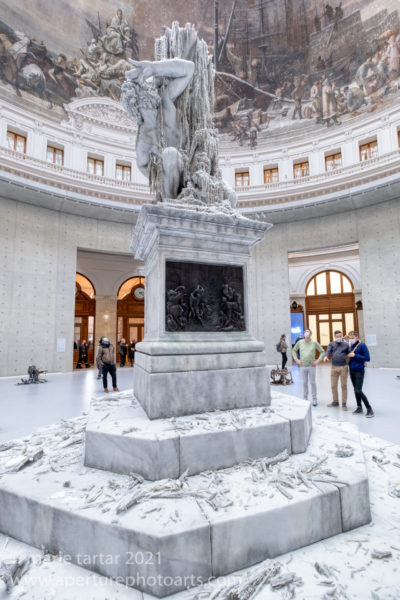
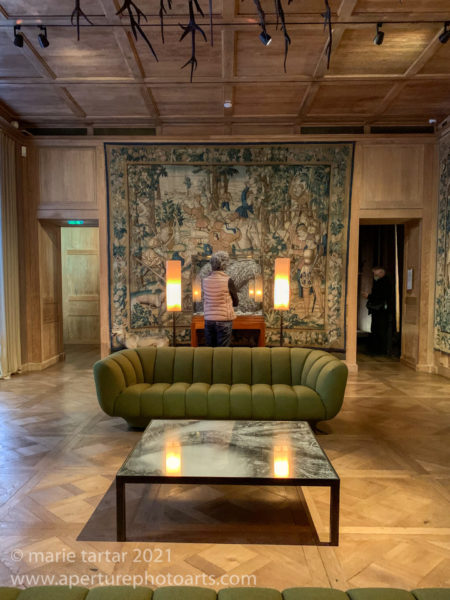


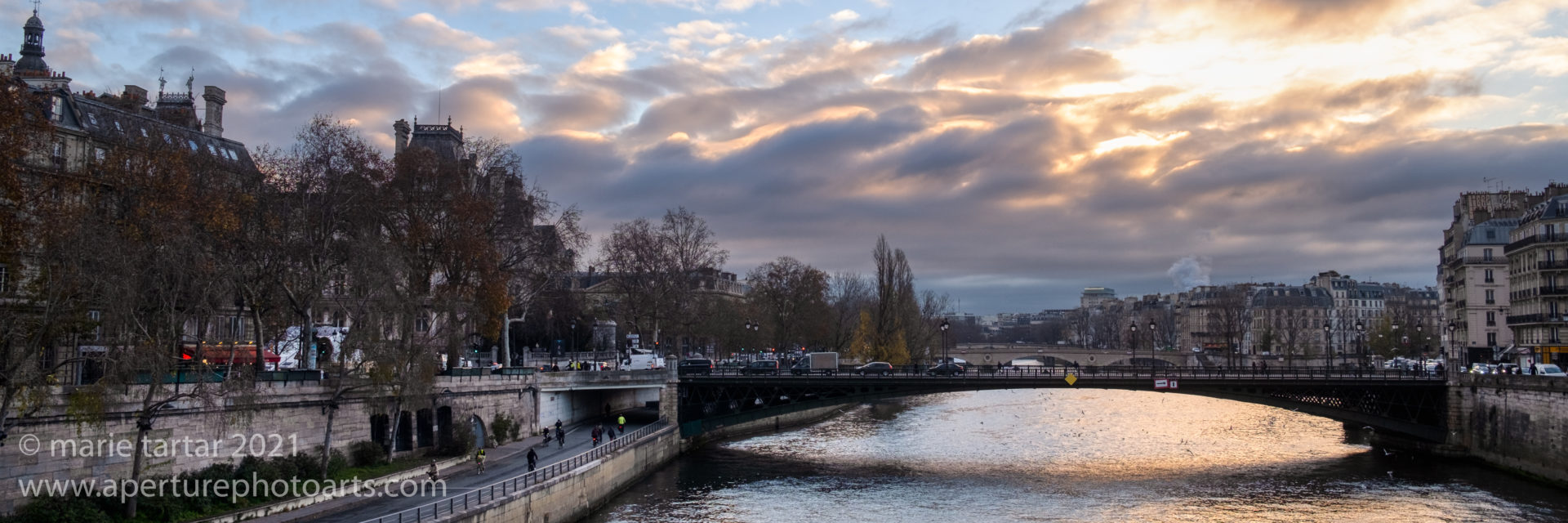


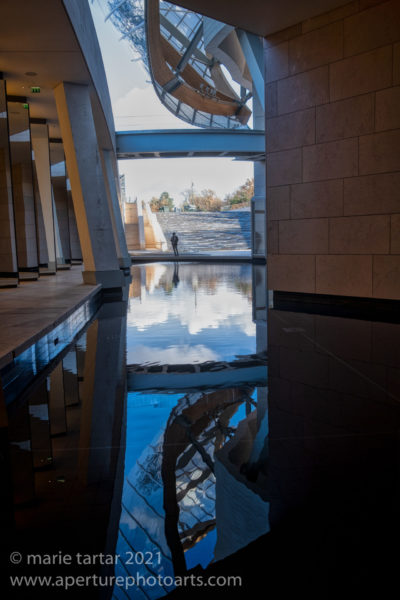
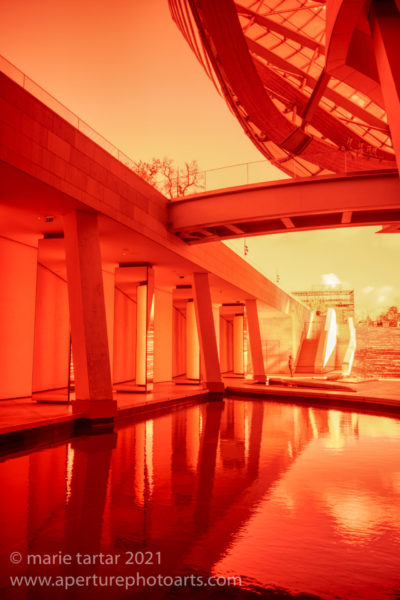
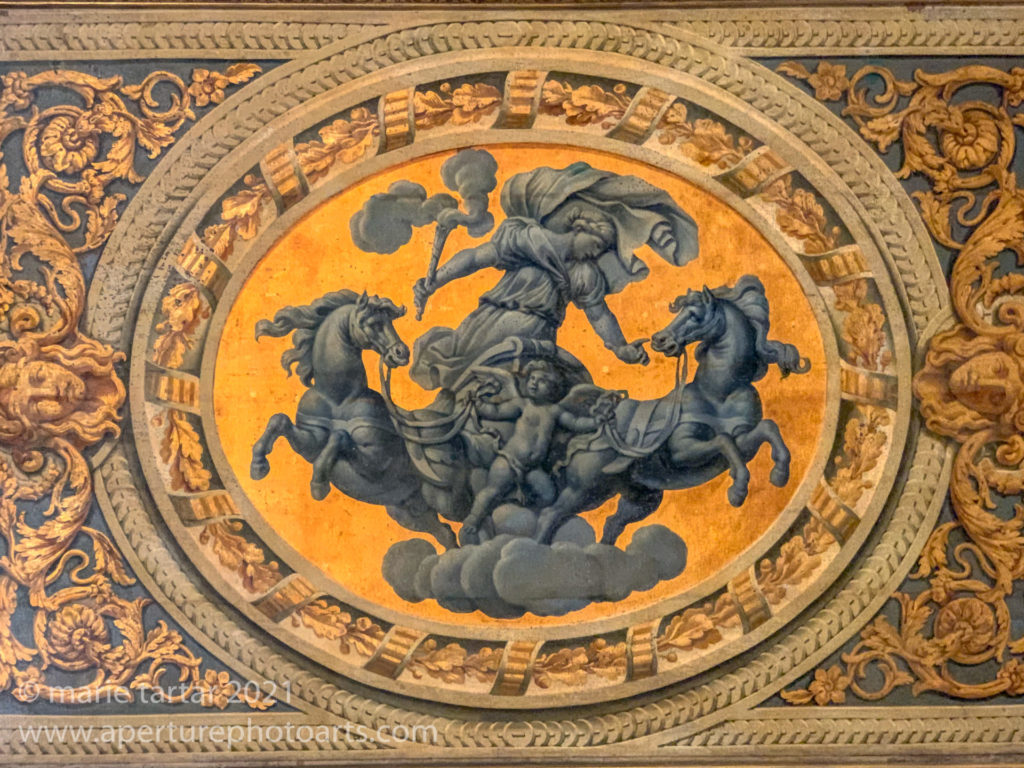
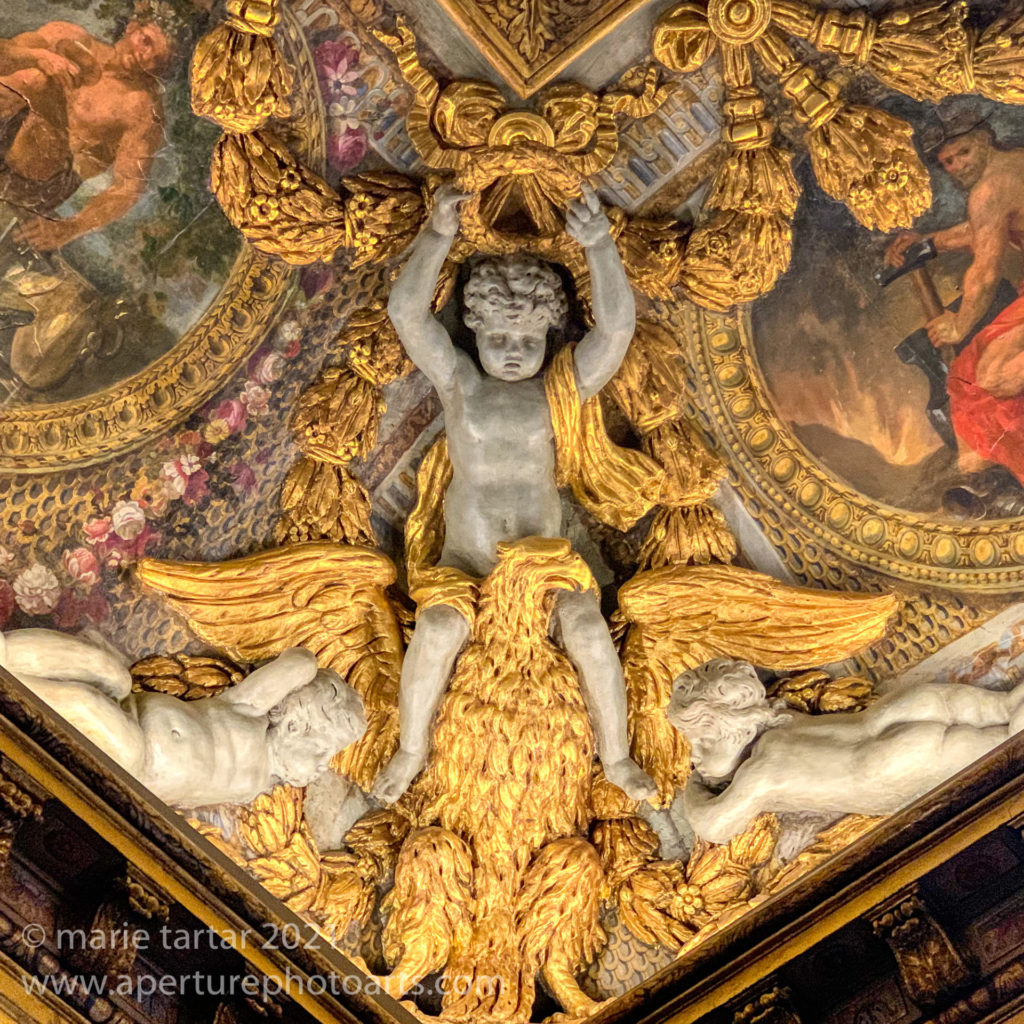


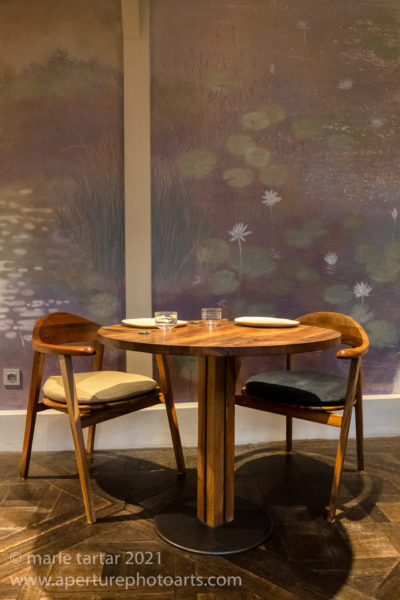

Thank you for taking me on a delightful, delicious Paris holiday!
Thanks for coming along-I was thinking of you and Randy when we were visiting his ancestor’s former home at Musée Canavalet!
-Marie
Thanks for sharing your wonderful Paris adventures!
We loved Chez L’Ami Jean and Semilla on past trips and glad to hear that they are still around.
Will try to go back to Paris this June along with Burgundy.
It definitely won’t be another 6 years before our next trip!
-Marie